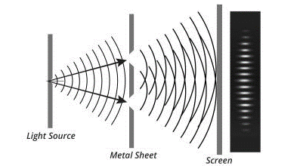Smiling atoms - الجسيمات المبتسمة
By: Omar Nabil Mahmoud
English Version
It all started as an experiment that was initiated because of a great debate about the light being a wave or a particle and escalated to something that Einstein himself died refusing to believe.
The double-slit experiment, also known as Young’s slits, was an experiment originally performed by Thomas Young in 1802 as a demonstration of the wave behavior of visible light.
The experiment consisted of a metal plate with two parallel slits in it, a laser beam that illuminates the slits, and a screen behind the plate to observe the results.
The results of the initial experiment were that light acted as a wave which resulted in an interference pattern as shown in figure (1) 
The pattern happens because the light creates two different waves each going out from one slit and an interference happens causing the pattern to accrue. The experiment answered some questions but not all.
when it was suggested that light is made of photons which are particles of matter, the experiment was revived once more, but
Instead of using a beam of light a device was made to release only one photon at a time, and what was expected is that photons are going to create a particle-like pattern because there is only one photon being launched at a time so no interference is possible as shown in figure(2).

The photons at first were being represented on the screen as singular photons which was expected but they were appearing in some form of a random pattern and here is where all the madness begins, after a while of running the experiment it turned out that those photons were not randomly placed but they were forming an interference pattern by themselves!!
It was not understood at all why photons do that, why does a singular photon produce a wave which then splits into two by each slit and then forms an interference pattern, and after all that combined to appear as a single photon on the screen?
And here is where another derivation of the experiment was introduced called the “Which-way” experiment, the point of it was to simply understand which slit the photons pass through, by placing a detector at the end point of the slits.
And as the nature of physics the results were far away from simple, the experiment began and the detector dated that exactly 50% of the electrons passed from each slit, and the most insane thing was seen, the photons that passed left a particle-like pattern instead of an interference pattern like what was seen in the same experiment but with the change of the existence of the detector(observer).
It was unrealistic to even think that the photons acted differently because they knew they were being watched. So to make sure, the scientists decided to leave the detector in its place but not turn it on, to see if the photons actually know that they are being watched, and the madness kept on going the electrons knew they were not being observed and they showed a fading pattern once more.
It was just like us humans when we know that we are being watched we act differently, when a camera is directed at us we smile. This is what happened with the photons, they somehow knew they were being observed and it caused the change in behavior. It was like they were smiling at us, and from that experiment, the idea of the Observer effect by Werner Heisenberg originated.
And that is where we start going into the mad world of modern physics and quantum mechanics to explain the phenomena and an explanation Einstein died refusing to believe. and is where I leave you, till we meet another time.
Arabic Version
بدأ الأمر كله بتجربة بدأت بسبب الجدل حول كون الضوء مكون من موجات أو من جزيئات وتطورت إلى أن وصلت لتفسيرات اينشتاين نفسه مات رافضا تصديقها.
التجربة بدأت على يد العالم توماس يانج في عام 1802 الذي كان يحاول أن يعرض تجربة توضح أن الضوء مكون من موجات وليس من جسيمات.
التجربة مكونة من ضوء ليزر يسطع على صفيحة معدنية بها شقين قريبين من بعض، وخلف تلك الصفيحة يوجد شاشة لتلقي الضوء عليها وعرض النتائج.
نتيجة التجربة كانت أن الضوء أظهر نمط تداخل ( صورة 1 ) ؛ ناتج عن أن موجات الضوء انقسمت عند مدخل كل شق لتكون موجة جديدة عند كل مخرج مما نتج عنه التداخل البناء والهدام، وكانت هذه نتيجة التجربة التي أثبتت أن الضوء له خصائص الموجات وليس الجسيمات. أجابت هذه التجربة عن بعض الأسئلة ولكن ليس كلها مثل ماذا إن كان للضوء كلا الخصائص الجسيمات والموجات معا

بعد بضع سنوات ظهرت نظرية اينشتاين كون الضوء مكون من جسيمات صغيرة تسمى فوتونات والتي لها خصائص الموجات، وهنا ظهرت تجربة ينج مرة اخرى. أراد العلماء تكرار التجربة ولكن بإستخدام الفوتونات الوحيدة عوضا عن أشعة الضوء.
وتم اعادة التجربة ولكن بإستخدام لة تقوم بإخراج الفوتونات فوتونا فوتونا ، وكان متوقع من التجربة ان يظهر نمطا يشبه نمط الجزيئات ( صورة 2 ) وليس الموجات حيث أن الجهاز يطلق فوتونا واحدا ولا يوجد أثر للموجات لتكون نمط تداخل

في بداية التجربة لم يحدث شيئا خارج عن المألوف بدأت الفوتونات في الظهور على الشاشة واحدة تلو الأخرى في نمط عشوائي نوعا ما ، ولكن لم يكن شيئا غريبا، ولكن بعد فترة بدأ الجنون ؛ اتضح أن النمط الذي أظهرته الفوتونات لم يكن نمطا عشوائيا، بل كان نمط تداخل!
بطريقة ما غير مفهومة أظهر فوتونا واحدا خصائص الموجة بنفسه بل وانقسم عند اصطدامه بالشقين لينتج كل شق موجة جديدة والتي نتج عنهم نمط تداخل، ولكن في النهاية ظهر فوتونا واحدا على الشاشة في مكان واحد ولم يكن هناك أثر للموجات التي تكونت.
النتائج كانت صدمة للعلماء ونتج عنها تغييرات في التجربة و تم تسميتها بتجربة (أي طريق)
الهدف من التجربة كان ببساطة وضع جهاز مراقب على الجانب الداخلي للشقوق ليلاحظ أي شق خرجت منه الفوتونات .
ولكن طبيعة الفيزياء تظهر في شكل النتائج التي لم تكن بسيطة أبدا، اتضح أن نصف الفوتونات مرت عن طريق كل شق من الشقوق، ولكن لم يكن هذا مطرح جنون هذه التجربة بل أن الفوتونات التي مرت قامت بتكوين نمط جزيئي على عكس ما ظهر في نفس التجربة قبل إضافة الجهاز المراقب.
النتائج كانت غير منطقية لكل العلماء، وكان من الجنون التفكير حتى في أن الجسيمات تفهم أنه يتم مراقبتها فينتج عن ذلك تغير في سلوكها. فقام العلماء بتعديل بسيط في التجربة، قامو بإبقاء كل شيئ كما كان مع تعديل طفيف، قاموا بإطفاء الجهاز المراقب ليروا إن كانت الفوتونات حقا تعلم أنه يتم مراقبتها وأنها ليست مجرد صدفة من نوع ما. وكانت النتائج الصادمة، عادت الفوتونات إلى شكلها الأصلي وشكلت نمط تداخلي على عكس ما كان من قبل.
واتضح أنه مثلما نقوم نحن بتغيير سلوكنا عندما نعلم أننا مراقبون وأحيانا نبتسم عندما يتم تصويرنا بالكاميرا، تقوم الفوتونات بنفس الشيئ وكأنها تبتسم لنا، و تغير من طبيعتها عندما تعلم أنه يتم مراقبتها؛ ومن هذه التجربة كانت بداية نظرية المراقب عن طريق العالم ورنر هايزنبرج.
و لنفسر ما حدث ولما حدث فسنضطر إلى أن ندخل في العالم الغريب للفيزياء الحديثة وفيزياء الكم، وهنا أتركك عزيزي القارئ إلى أن نلتقي في وقت آخر
References
[1]Darling, D. (no date) Wave-particle duality, The Worlds of David Darling. Available at: https://www.daviddarling.info/encyclopedia/W/wave-particle_duality.html
[2]Examine Thomas Young’s double-slit experiment that challenged Isaac Newton’s theory of light (2022) Encyclopædia Britannica. Encyclopædia Britannica, inc. Available at: https://www.britannica.com/video/179685/experiment-Thomas-Young
[3]Jones, A.Z. (2019) What you need to know about wave particle duality, ThoughtCo. ThoughtCo. Available at: https://www.thoughtco.com/wave-particle-duality-2699037
[4] Mir, R. et al. (2007) “A double-slit ‘which-way’ experiment on the complementarity–uncertainty debate,” New Journal of Physics, 9(8), pp. 287–287. Available at: https://doi.org/10.1088/1367-2630/9/8/287.

